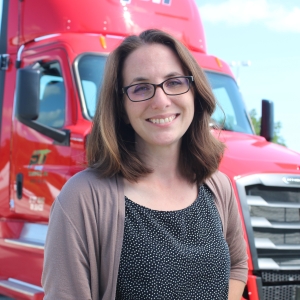 The first goal for any truck driver recruiter is to bring in the best drivers to their organization. The second is to bring those drivers in quickly and efficiently. We’ve talked about how important it is to keep drivers moving through your hiring pipeline quickly, but what’s the best way to do this? Here are 4 ways that your carrier can use recruitment automation to hire drivers faster.
The first goal for any truck driver recruiter is to bring in the best drivers to their organization. The second is to bring those drivers in quickly and efficiently. We’ve talked about how important it is to keep drivers moving through your hiring pipeline quickly, but what’s the best way to do this? Here are 4 ways that your carrier can use recruitment automation to hire drivers faster.
1. Finding and Engaging Drivers
 Your recruiting team only has so many hours in the day, and sometimes those hours can get allocated to tedious, clerical tasks that aren’t directly related to hiring drivers. Using recruitment automation technology helps with those tasks so your recruiters can spend their time connecting with drivers.
Your recruiting team only has so many hours in the day, and sometimes those hours can get allocated to tedious, clerical tasks that aren’t directly related to hiring drivers. Using recruitment automation technology helps with those tasks so your recruiters can spend their time connecting with drivers.
Engaging and Nurturing Drivers
Once a driver applies to your job, what happens next? Is the driver contacted immediately or does it take your team a bit to reach out? Automate this process by introducing nurturing campaigns that instantly contact interested drivers with next steps, all while not sacrificing the personal touch. Consider platforms that have multi-channel capabilities including chatting, emailing, and texting.
Automated Job Distribution
When you post a new CDL driver job on your website, do you then have to manually share that opening across all the other channels you want it to be on? Save hours of your time by partnering with channels that will automate your job distribution efforts to different job boards and hiring sites.
Corporate Website and Career Page
Your website is your virtual first impression to driver candidates. If a driver is interested in working for your carrier, can they quickly find the information they need? Within one or two clicks, are they able to find your open jobs?
If not, making some updates to your website is something you should consider. In addition, keeping your career page updated with open positions and integrating application forms with your recruiting software will save you time in the long run.
2. Tracking Applicants and Interviewing
 Once you have a steady flow of driver applicants for your open positions, what’s next?
Once you have a steady flow of driver applicants for your open positions, what’s next?
Applicant Tracking System
Pushing your interested drivers to your Applicant Tracking System (ATS) is another way you can use automation to improve the speed of your hiring process. You can continue to nurture drivers once they are added to your ATS by setting up and monitoring campaigns that allow you to automate periodic interactions.
Interviewing
Once you’re ready to start interviewing drivers, automating the process around scheduling interviews and following up with candidates is key to saving you time.
3. Verifying Employment and Background Screening
 Screening is an important part of the hiring process in all industries, but it’s vital for making safe hires in transportation. Using the right tools to automate your screening process can be the key to ensuring you’re hiring safe, qualified drivers.
Screening is an important part of the hiring process in all industries, but it’s vital for making safe hires in transportation. Using the right tools to automate your screening process can be the key to ensuring you’re hiring safe, qualified drivers.
Employment Verification
The FMCSA requires that every candidate go through a comprehensive screening process before they’re fully hired. A big part of this screening process is verification of employment (VOE). If you’re still doing VOEs on paper forms and faxing documents to verify a driver’s work history, you can save time and money in the long run by having this process automated.
Background Screening
In addition to verifying employment history, a full background screening is necessary to ensure quality hires. The following information is typically collected during a background check:
- Criminal records check
- Drug and alcohol test
- License check
- Motor vehicle records check
- Physical health exam
- Sex offender status
There are different applications out there that can run background checks for you automatically, so you know you’re not missing any critical piece of information that would cause you to not make a hire.
4. Hiring and Onboarding
 We know that recruitment automation can help you find driver candidates more quickly. But what about after you find them? Where can you continue to automate processes with your employees?
We know that recruitment automation can help you find driver candidates more quickly. But what about after you find them? Where can you continue to automate processes with your employees?
The hiring and onboarding process is another part of the hiring pipeline that can benefit from automation. Using electronic forms instead of requiring candidates to come into the office to fill out paperwork is a huge time saver for both the driver and the carrier.
If your team is looking for a better way to recruit drivers, consider working with a recruiting partner like Drive My Way. We’re ready to help you put together a plan that best fits your needs, and help you recruit drivers that are the best fit for your open positions.

 Comprehensive CDL Recruitment Solutions
Comprehensive CDL Recruitment Solutions
 For the vast majority of the American workforce, their workday is fixed. Once their shift is over, they’re able to go home and spend their free time with their family and friends and sleep in their own bed.
For the vast majority of the American workforce, their workday is fixed. Once their shift is over, they’re able to go home and spend their free time with their family and friends and sleep in their own bed.  For any carrier that is serious about not only recruiting, but retaining top talent, making a concerted effort to offer their drivers a quality work life balance is a must. This means not only offering a blanket home time policy but being flexible with the individual needs of your drivers.
For any carrier that is serious about not only recruiting, but retaining top talent, making a concerted effort to offer their drivers a quality work life balance is a must. This means not only offering a blanket home time policy but being flexible with the individual needs of your drivers.  “We pride ourselves on planning to have our regional drivers home every weekend, as is promised during the recruitment process. As a company, this is very important to us because our owner was a driver himself and understands how vital home time is for our drivers. Additionally, we do our absolute best to tailor home time to the needs of each specific driver, whether it be more/less home time, or being home on certain days of the week.”
“We pride ourselves on planning to have our regional drivers home every weekend, as is promised during the recruitment process. As a company, this is very important to us because our owner was a driver himself and understands how vital home time is for our drivers. Additionally, we do our absolute best to tailor home time to the needs of each specific driver, whether it be more/less home time, or being home on certain days of the week.”  “Our driver managers are trained to understand the importance of work and home life balance. We have programs in place to assure that our drivers get the home time they need. Driver satisfaction has always been important at ARD Trucking since the very beginning. We make home time one of our top priorities.”
“Our driver managers are trained to understand the importance of work and home life balance. We have programs in place to assure that our drivers get the home time they need. Driver satisfaction has always been important at ARD Trucking since the very beginning. We make home time one of our top priorities.” No matter how good of a home time policy you have, OTR and Regional drivers still spend a lot of time away from home. A good way to make drivers feel more comfortable on the road is to let them bring a little piece of home with them, whether that’s by offering a Rider/Pet policy, or upgrading your
No matter how good of a home time policy you have, OTR and Regional drivers still spend a lot of time away from home. A good way to make drivers feel more comfortable on the road is to let them bring a little piece of home with them, whether that’s by offering a Rider/Pet policy, or upgrading your  Giving drivers a quality work life balance is extremely important, but it’s only one piece of the driver
Giving drivers a quality work life balance is extremely important, but it’s only one piece of the driver 
 “The holiday season, also known as peak season, is typically our busiest time of year. From Thanksgiving through New Year’s, our dedicated lanes usually double or triple in volume and frequency. We find ourselves doing multiple runs to the same locations per day to keep up with the extra freight that is being shipped. We also take on some new pickups/lanes that are seasonal only.”
“The holiday season, also known as peak season, is typically our busiest time of year. From Thanksgiving through New Year’s, our dedicated lanes usually double or triple in volume and frequency. We find ourselves doing multiple runs to the same locations per day to keep up with the extra freight that is being shipped. We also take on some new pickups/lanes that are seasonal only.”










 It’s a driver’s market. If you want to be a trucking recruiter who
It’s a driver’s market. If you want to be a trucking recruiter who This might seem obvious, especially to an experienced truck driver recruiter, but it couldn’t be more important. The Commercial Carrier Journal
This might seem obvious, especially to an experienced truck driver recruiter, but it couldn’t be more important. The Commercial Carrier Journal  Gone are the days where a clean, mobile-friendly user interface was a nice, extra touch used by only the most tech-savvy trucking recruiters. According to the 2019
Gone are the days where a clean, mobile-friendly user interface was a nice, extra touch used by only the most tech-savvy trucking recruiters. According to the 2019  Coming into a new year or quarter, it is tempting to take on a heavy load, but don’t get caught in the frenzy. Your hours are limited. Take the time to prioritize your leads based on urgency and fit early on to increase your overall productivity.
Coming into a new year or quarter, it is tempting to take on a heavy load, but don’t get caught in the frenzy. Your hours are limited. Take the time to prioritize your leads based on urgency and fit early on to increase your overall productivity. As a trucking recruiter, you may feel like building relationships isn’t the best use of your time, but that couldn’t be further from the truth. Even when time is of the essence, you can’t afford not to get to know your potential drivers.
As a trucking recruiter, you may feel like building relationships isn’t the best use of your time, but that couldn’t be further from the truth. Even when time is of the essence, you can’t afford not to get to know your potential drivers. Hiring truck drivers is a competitive business. Driver recruiters are always trying to find new ways to get a leg up on the competition and bring in the best drivers to their fleets.
Hiring truck drivers is a competitive business. Driver recruiters are always trying to find new ways to get a leg up on the competition and bring in the best drivers to their fleets.  People are more likely to trust people who are like them over people who aren’t. This is why
People are more likely to trust people who are like them over people who aren’t. This is why  Though trucking remains an industry dominated by older males, there has been a
Though trucking remains an industry dominated by older males, there has been a  Many carriers still use recruiting processes which are outdated and cumbersome. You can stand out to truck driver candidates by adopting technology to make recruiting more efficient.
Many carriers still use recruiting processes which are outdated and cumbersome. You can stand out to truck driver candidates by adopting technology to make recruiting more efficient.  First impressions are extremely important in the recruiting process. When a driver candidate visits your company website or social media page for the first time, would you rather them be greeted by nothing but one company update from five years ago, or a number of blog posts, company photos, and videos sharing your company values and culture?
First impressions are extremely important in the recruiting process. When a driver candidate visits your company website or social media page for the first time, would you rather them be greeted by nothing but one company update from five years ago, or a number of blog posts, company photos, and videos sharing your company values and culture?  Custom Commodities Transport Partners with Drive My Way for Success
Custom Commodities Transport Partners with Drive My Way for Success

 The number one reason that truck drivers end up declining a job is because they’ve already accepted a different offer that reached them first. This is why quickly moving your candidates through the recruiting pipeline is so important.
The number one reason that truck drivers end up declining a job is because they’ve already accepted a different offer that reached them first. This is why quickly moving your candidates through the recruiting pipeline is so important. Time isn’t the only way to measure efficiency in recruiting. Cost per hire or CPH is an essential metric that measures how
Time isn’t the only way to measure efficiency in recruiting. Cost per hire or CPH is an essential metric that measures how  Gone are the days of putting up some flyers and placing your job ad in the newspaper. Digital is king now, with most interested drivers coming from Google searches,
Gone are the days of putting up some flyers and placing your job ad in the newspaper. Digital is king now, with most interested drivers coming from Google searches,  The above metrics take into account truck driver recruiting efforts before the job starts. But those aren’t the only ones you should be looking at. Connecting recruiting efforts with the quality of your hires and their first-year job performance can help you see if your recruiting team is going after the right candidates.
The above metrics take into account truck driver recruiting efforts before the job starts. But those aren’t the only ones you should be looking at. Connecting recruiting efforts with the quality of your hires and their first-year job performance can help you see if your recruiting team is going after the right candidates.  Measuring driver satisfaction is one of the secrets to measuring recruiting success and maximizing driver retention. Drivers and fleets are both looking for a strong match. If drivers aren’t happy with their carrier, it’s only a matter of time before they start looking elsewhere. Given the current state of the trucking industry, your fleet can’t afford to lose a driver after already spending resources on hiring and onboarding.
Measuring driver satisfaction is one of the secrets to measuring recruiting success and maximizing driver retention. Drivers and fleets are both looking for a strong match. If drivers aren’t happy with their carrier, it’s only a matter of time before they start looking elsewhere. Given the current state of the trucking industry, your fleet can’t afford to lose a driver after already spending resources on hiring and onboarding. 





